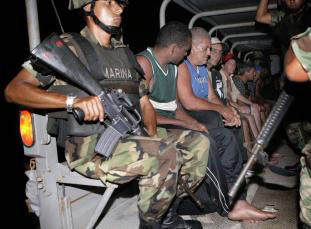
|  |  |  News Around the Republic of Mexico | July 2008 News Around the Republic of Mexico | July 2008  
Cubans Using Mexico as Springboard to U.S.
 Dudley Althaus - Houston Chronicle Dudley Althaus - Houston Chronicle
go to original


| | Cubans are escorted by Mexican navy soldiers after being arrested in Cancun on June 6. (Israel Leal/Associated Press) | | |
Playa del Carmen, Mexico — Most of the millions of visitors to Mexico's Caribbean coast can't wait to plunge into the turquoise waters, but a growing number come with exactly the opposite intention.

The thousands of Cubans illegally sailing here on makeshift rafts or sleek speedboats scramble for dry land as quickly as possible, most of them bound for the Texas border and asylum in the United States.

At least 11,500 Cubans entered the U.S. overland from Mexico last year, nearly double the 6,100 in 2004. All but a few hundred of the Cubans claiming "dry foot" asylum on the border last year crossed from Brownsville to Laredo, an average of 30 people a day.

Under the so-called "wet foot/dry foot" clause, U.S. law provides Cuban residents the right to legal entry and eventual residency if they set foot on U.S. soil. Most of those caught at sea are returned to Cuba.

Increased U.S. Coast Guard patrols in recent years have made the 90-mile sail to the Florida Keys far riskier for would-be refugees. The coast of Mexico's Quintana Roo state, about 120 miles from Cuba, and those of Central America to the south have become preferred destinations.

Less frequent Mexican naval patrols make the prospect of a sea capture more unlikely. And even many of those detained offshore are eventually released by Mexican authorities and sent off with a wink northward.

"Mexico doesn't have the technology, the ships, the radar to stop the flow," said Eduardo Matias Lopez, who heads the Cuban-Mexican Civic Association, which assists Cuban migrants passing through the country.

From the Yucatan Peninsula, the Cubans make their way by bus or plane to the U.S. border, often shepherded by smugglers who provide forged papers or "make arrangements" with Mexican police or customs officials.

Turn themselves in

Hundreds of thousands of undocumented migrants from Mexico and other countries slipping across the border each year strive to avoid American authorities. The Cubans simply walk up to the nearest immigration official and turn themselves in. Most are on their way with legal status before sunset.

"Normally the process takes only a couple of hours, if everything is in order," said Mucia Dovalina, a spokeswoman for U.S. Customs and Border Protection in Laredo.

"It's a total win-win," said Marc Rosenblum, a fellow at the Migration Policy Institute in Washington, D.C. "You're much more likely to make the crossing safely."

Safely, but not necessarily soundly.

Like would-be immigrants from Central America, China and around the world, the Cubans using Mexico as a springboard into the United States often find themselves at the mercy of either smugglers, officials or both, Matias said.

Bribes along the way

The going rate for being smuggled in a good boat is $10,000, payable upon arrival. And corrupt officials along the route, he said, often shake down the immigrants.

"They are highly valued merchandise," Matias said of the Cubans. "Everyone knows the Central Americans don't have any money. But everyone thinks all Cubans have relatives in Miami who are rich."

A scandal three weeks ago pointed to both the ease with which the Cubans often make the journey, and the corruption that allows them to do so.

Smugglers aided by Mexican immigration officials hijacked a government bus, carrying 33 Cubans who had been caught at sea, as it was en route to a detention facility. Eighteen of the pilgrims turned up a few days later at the border near McAllen, and were given legal entry.

An embarrassed Mexican government sacked the senior immigration officials in Cancun and elsewhere along the coast. Naval commanders were abruptly reassigned. New regulations were announced, in which immigration officials of all ranks were to be vetted.

The shake-ups might be having some impact, if only briefly.

Local officials bypassed

This week, Mexican federal agents flown in from Mexico City swooped down on a smugglers' safehouse in a middle-class Cancun neighborhood, seizing 18 Cuban men and two women.

The operations bypassed the local immigration officials. And the Cubans were flown to custody in Mexico City.

Mexican and Cuban negotiators are meeting in Havana again this month to work out an accord which both government's say will stop the migration through Mexico.

That may happen. Or maybe it won't.

"As long as 'wet foot/dry foot' is in place," said Rosenblum, the immigration analyst, "there is no way to stop the smuggling."

dudley.althaus(at)chron.com |

 |
|  |



